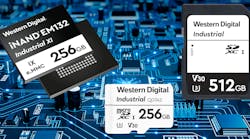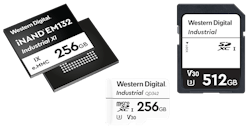Embedded developers usually have more demanding requirements than consumer products, where 3D NAND flash has taken the world by storm. It has made solid-state drives (SSDs) the norm, pushing hard-disk drives (HDDs) to the side. Likewise, embedded developers tend to prefer flash storage, but the capacities and price for single-level-cell (SLC) flash has been expensive.
Western Digital is well-known for its consumer and enterprise storage solutions. The company’s latest embedded products include rugged e.MMC, SD card, and MicroSD devices that are built using 64-layer 3D NAND flash (see figure).
Western Digital’s new 3D NAND flash storage includes e.MMC iNAND EM132 (left), the microSD (center), and SD card (right) form factors.
The e.MMC iNAND EM132 EFD chips come in capacities up to 256 GB. They meet the e.MMC 5.1 standard that supports backward compatibility. The standard version supports a temperature range of –25 to +85°C, while the extended temperature range pushes the lower limit to −40°C. As a result, the devices can be used in demanding application areas such as automotive.
The high-endurance, triple-level-cell (TLC) flash memory is rated at 3K program/erase cycles and write endurance of 693 TB. Sequential read/write performance is 310/150 MB/s with random read/write IOPS of 20K/12.5K. The chips support smart partitioning and manual refresh, as well as provide an advanced health reporting system. The commercial-grade products include enhanced user data area support. The chips come in an 11.5- × 13-mm package.
The SD card solution is available in both temperature ranges in capacities up to 512 GB; the endurance is rated at 1536 TB. It has a mechanical write protect switch. Features include a programmable ID, host lock support, secure firmware upgrade capability, error correction, and health status meter support. Sequential read/write speeds are 100/50 MB/s.
The industrial-grade microSD cards are available with the same temperature ranges as the EM132 EFD. They also come in capacities up to 256 GB with a write endurance up to 768 TB. As with the SD cards, the microSD features include a programmable ID, host lock support, secure firmware upgrade capability, error correction, and health status meter support. The cards achieve Speed Class 10, U1/U3, and V10/V30 performance with sequential read/write speeds of 100/50 MB/s.



